Or rather well past time for some real action on Climate Change was the message of a large and largely unreported protest in London at the start of March. In my account at Time to Act on Climate Change I began “Over 20,000 protesters marched through London” and while it is hard to be definite about the exact figures at such events it was certainly a large protest.
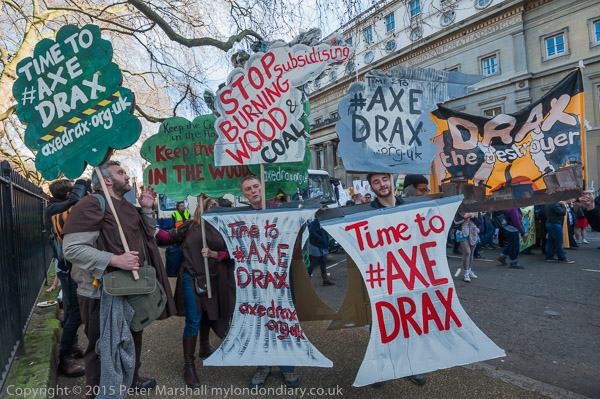
Time to #AxeDrax
Over forty-five years ago, when I first began to think about environmental issues (and even to speak in public on them), climate change was something that would happen in the future, the stuff of post-apocalyptic fiction such as J G Ballard’s ‘The Drowned World‘, first published in 1962 (though I only read it much later.) Now it is very much with us, and among the pile of discarded papers I moved to find my keyboard this morning I came across an article about wine producers buying up estates in Kent and Sussex as the Champagne region is becoming too warm.
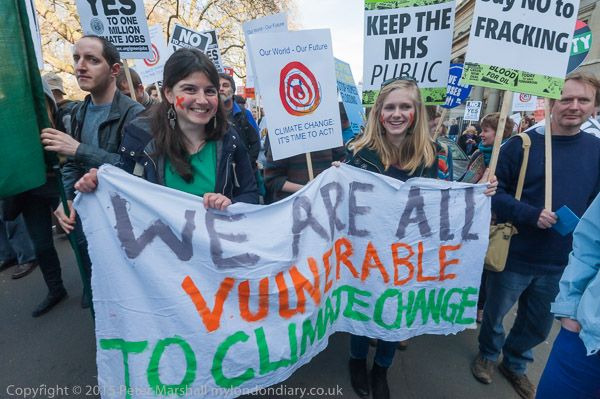
Champagne is perhaps the least of worries for most of this, though perhaps not for those in the 1% whose opinions driven by wealth really matter. But unlike many of those associated with global warming, one that is easily overcome by a simple shift of location. Less easy to solve the problems of countries such as the Marshall Islands or Bangladesh already suffering from rising sea levels and global climate instability.
Last September, ahead of the New York Climate summit we had another large march in London, the Peoples Climate March, about which I commented that it seemed to have been “taken over by various slick and rather corporate organisations rather than being a ‘people’s march’ and seemed to lack any real focus.” Although some of those same organisations were backing this march, they were far less visible, and it was far more a march dominated by climate activists and grass roots organisations.
The important arguments are no longer I think about environmental or scientific details (though of course the detailed matters of ecology remain vital) but of politics – how we get the change we know is vital to save life on this planet, if indeed that is possible. How are that small and wealthy elite – the 1% or perhaps rather fewer – to be persuaded to abandon their own increasingly insulated lifestyle of extravagance based on planetary exploitation for the sake of a future for the rest of us. Can it be achieved within the institutions – including governments – which they dominate or will it only happen through catastrophe or revolution?
Protests such as those I spend much of my time photographing often don’t acheive their aims, often indeed are asking the impossible, often are doomed to failure, but that doesn’t mean they are unimportant. There are sometimes small victories, but even more vitally they serve to bring issues into the open, to manage to break through the dictatorship of the elite over the public agenda, to slightly rock the government boat. They are the way that many things start to happen. And even in my gloom, especially in it, there is hope that something may happen over climate change. And much of that hope comes from the people that appear in my pictures and what they are doing.
The event began in Lincoln’s Inn Fields, the largest public square in London, including the surrounding roads around 250 yards by 180 yards, enough to make a large crowd look fairly sparse. As the front of the march was leaving from the south-west corner, people were still flooding in to the square from Holborn station and High Holborn. It took around 35 minutes before the last of the march – which at the start was fairly tightly packed – to leave the square. The “Over 20,000” was the organiser’s estimate, and my own guess would have been a little lower. But where most of the media talk about hundreds when thousands are on the streets a little overestimate helps to balance things.
I stayed taking photographs in Lincoln’s Inn Fields until the end of the march had got fairly close to the start point, and then rushed off to catch up with its front. I had the advantage of being able to take a short cut where the marchers went around the one-way system at Aldwych, and they had been walking rather slowly with frequent stops, and I caught up halfway down the Strand.
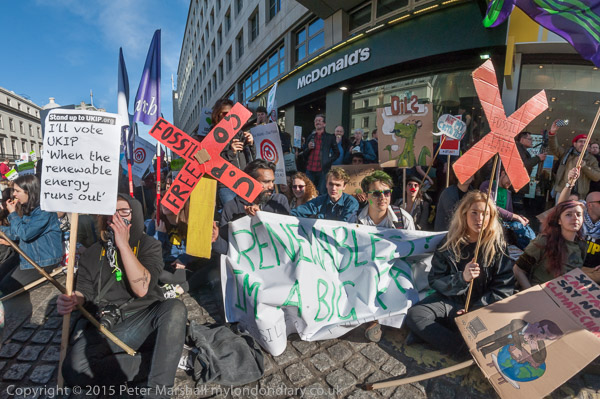
‘Renewables – I’m a Big Fan’. Fossil Free Pompey at McDonald’s
Ahead of us were several places where I thought some of the marchers might decide to make some kind of protest, and I kept close to a group who I thought might be involved in this. And as we approached McDonald’s I was not surprised when things livened up. But the police had also for once anticipated the action too, and McDonald’s had extra security staff on the door. Instead of trying to enter, people sat down in the road, and hundreds of other marchers followed their example, blocking the street and stopping the march.
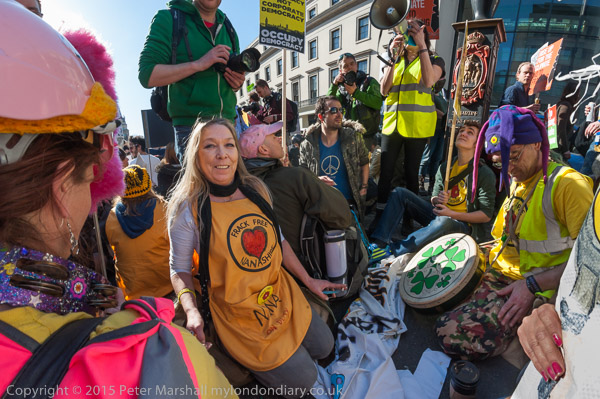
Tina-Louise Rothery and friends on the Strand
The low winter sunlight made photography difficult, with areas of deep shade and bright sun. Working with an extreme wide-angle as I mainly was, using fill-flash was impracticable, and although I tried hard to avoid blown highlights I wasn’t always successful. After making some pictures close to McDonalds I stepped over protesters who were sitting or lounging on the road to get across to a group of anti-fracking protesters towards the far side of the road and joined them to take pictures. Among them were several, including Tina-Louise Rothery and some of the other ‘Nanas’ who I’d met at previous protests, who it was good to meet again. It does make working with the 16mm fisheye easier when the people you are photographing know you and are happy to be photographed at close quarters.
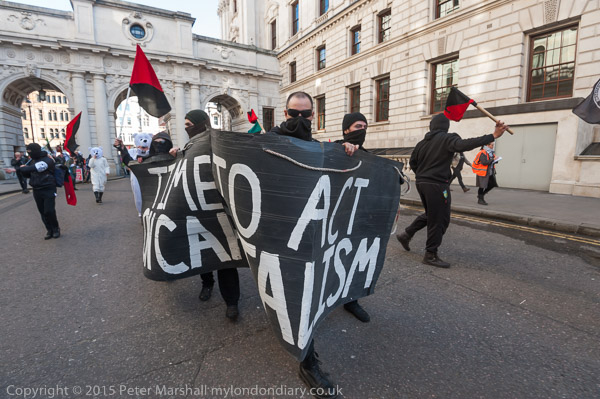
Time to Act on Climate Change
After a few minutes the protesters got up and the march moved on, though the corner of Trafalgar Square and turning down Whitehall. Here the black bloc came to the front of the march, and I expected some lively scenes at Downing St. There was a little shouting and they were joined by a small group of polar bears, but soon they were on their way again. On reaching King Charles St they rushed off down it, followed by a small group of marchers. I ran down with them for a short distance, and then had to decide whether to stay with them or the main march.
Their protest might well have provided some images of clashes with police and of minor damage to property that would be likely to be used by the mass media. Thinking purely in terms of likely use of images and possible sales, I should have stuck with the black bloc. And I think like most photographers I welcome the adrenaline of confrontations. But I’m not happy with the way that such images are used by a press and broadcasting establishment dominated by the 1%, which picks on such things to obscure or denigrate the main issues. I vacillated, then turned around and ran back to photograph the main march as it came into Parliament Square.
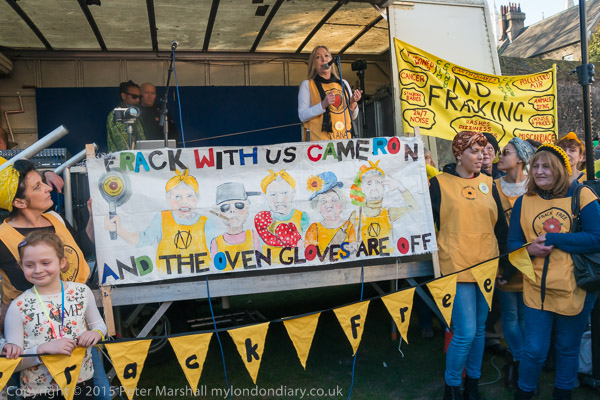
‘Frack With Us Cameron and the Oven Gloves are Off’
I was anxious too not to miss the rally on College Green and the opportunity to photograph the speakers and the crowd there. Though there was relatively little press interest as the only major celebrity input came from a video link with Vivienne Westwood speaking from Paris. But there were some interesting speeches and speakers, including John McDonnell and Caroline Lucas, Matt Wrack and others, with Tina-Louise Rothery bringing Frack Free Lancashire activists with her and John Stewart coming on with some of the polar bears who had protested earlier in the day at Heathrow.
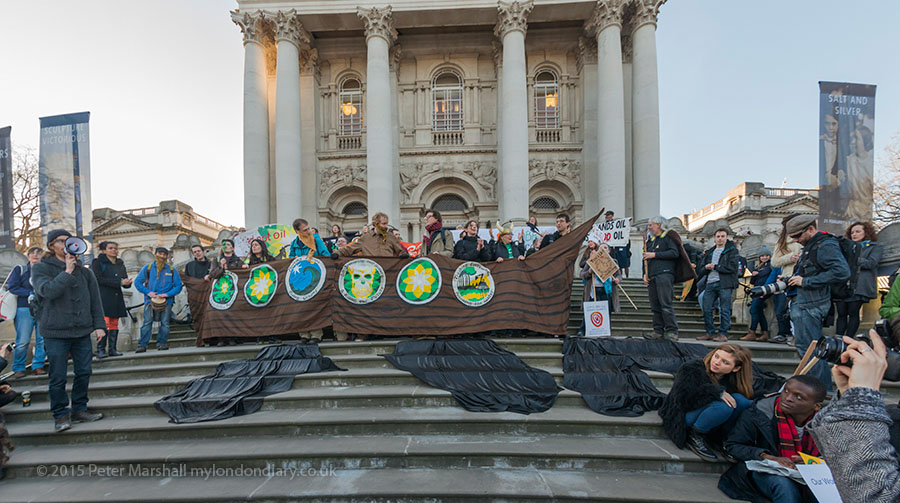
Almost corrected image of the Viking Longship and oil slicks against BP sponsorship of Art by ‘Art Not Oil’
At the end of the rally I had another choice to make. I could either go back north to Parliament Square and Westminster Bridge with activists likely to face confrontation with the police, or go south with Art Not Oil‘s Viking ship to protest on the steps of Tate Britain. Either would have taken me towards a station from which I could catch a train home, something my body was telling me it was time to do. Although Parliament Square would have been more exciting it was also more open-ended with perhaps hours of police kettles and confrontation, I went with the ship simply as a quick and easy option. I’d done enough and needed a rest and dinner.
More at:
Time to Act on Climate Change
Climate Change Rally
Viking longship invades Tate steps
______________________________________________________
My London Diary : Buildings of London : River Lea/Lee Valley : London’s Industrial Heritage
All photographs on this and my other sites, unless otherwise stated, are taken by and copyright of Peter Marshall, and are available for reproduction or can be bought as prints.
To order prints or reproduce images
________________________________________________________